Zara's Vertical Integration vs. Outsourcing in Fashion Industry
VerifiedAdded on 2023/01/13
|7
|1852
|57
Essay
AI Summary
This essay critically evaluates the advantages and disadvantages of vertical integration versus outsourcing within the fashion industry, focusing on Zara as a prominent example. The essay begins with a company background of Zara, highlighting its organizational structure, products, and key quality issues. It then synthesizes the core concepts using Porter's Value Chain Model and McKinsey's 7S Model to compare Zara's practices with those of its competitors, H&M and Marks & Spencer. The analysis covers primary and secondary activities within the value chain, as well as strategic, structural, and operational aspects of the 7S model. The essay examines the operational management of Zara and its competitors, emphasizing key differences and special features. The conclusion synthesizes the findings and recommends outsourcing as a strategic option for Zara. The essay utilizes various academic sources to support its arguments and provides a comprehensive overview of supply chain management in the fast-fashion industry.
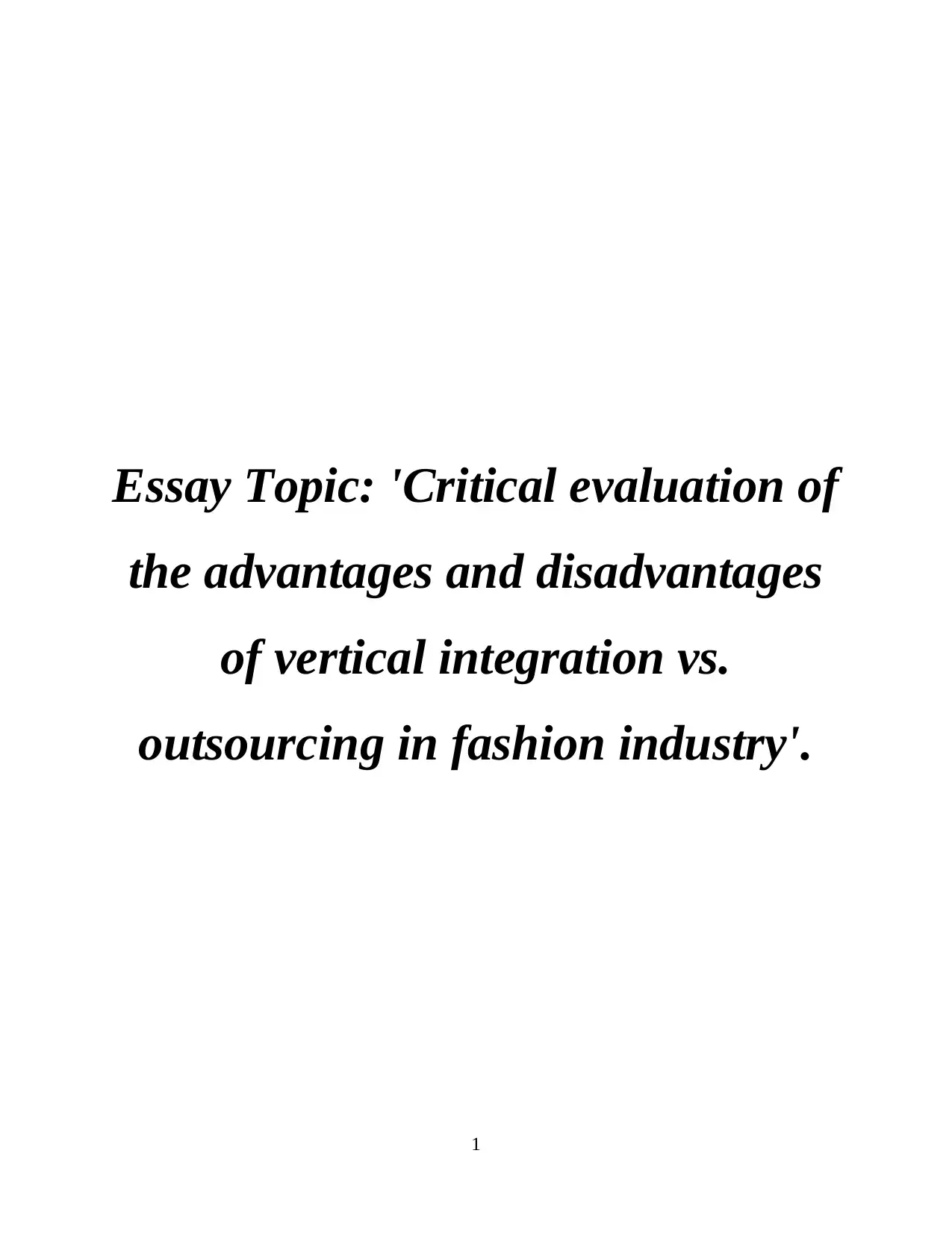
Essay Topic: 'Critical evaluation of
the advantages and disadvantages
of vertical integration vs.
outsourcing in fashion industry'.
1
the advantages and disadvantages
of vertical integration vs.
outsourcing in fashion industry'.
1
Paraphrase This Document
Need a fresh take? Get an instant paraphrase of this document with our AI Paraphraser
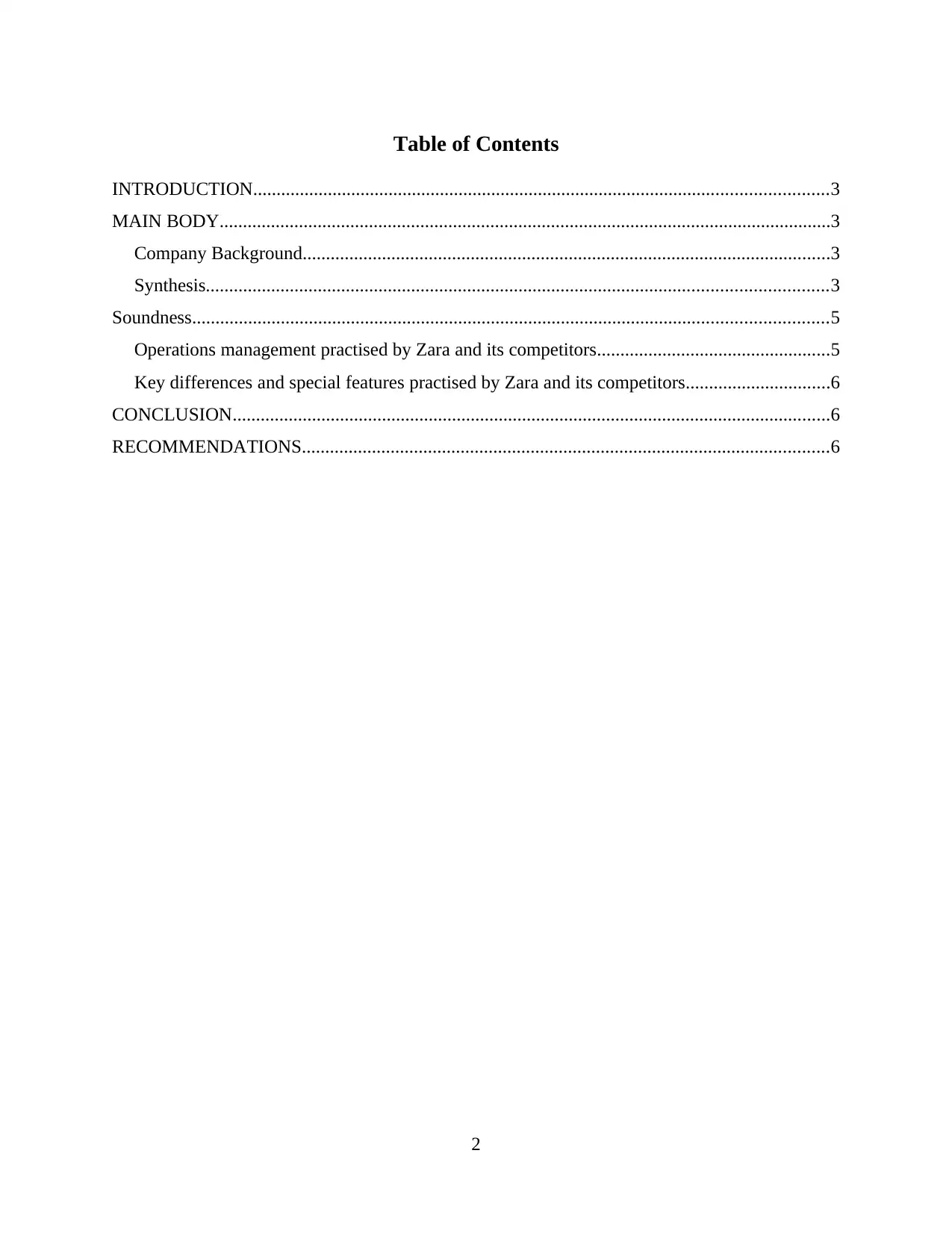
Table of Contents
INTRODUCTION...........................................................................................................................3
MAIN BODY...................................................................................................................................3
Company Background.................................................................................................................3
Synthesis.....................................................................................................................................3
Soundness........................................................................................................................................5
Operations management practised by Zara and its competitors..................................................5
Key differences and special features practised by Zara and its competitors...............................6
CONCLUSION................................................................................................................................6
RECOMMENDATIONS.................................................................................................................6
2
INTRODUCTION...........................................................................................................................3
MAIN BODY...................................................................................................................................3
Company Background.................................................................................................................3
Synthesis.....................................................................................................................................3
Soundness........................................................................................................................................5
Operations management practised by Zara and its competitors..................................................5
Key differences and special features practised by Zara and its competitors...............................6
CONCLUSION................................................................................................................................6
RECOMMENDATIONS.................................................................................................................6
2
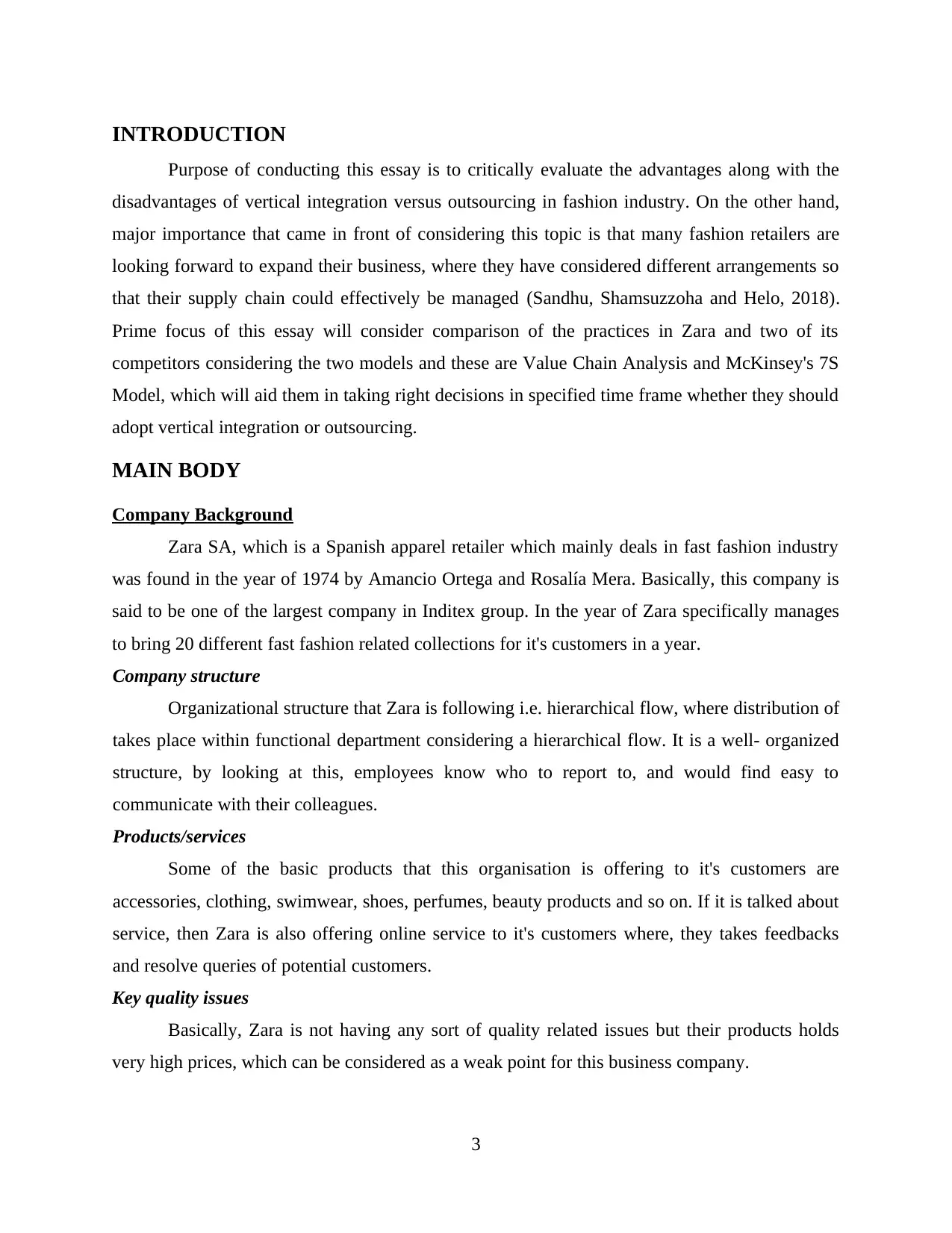
INTRODUCTION
Purpose of conducting this essay is to critically evaluate the advantages along with the
disadvantages of vertical integration versus outsourcing in fashion industry. On the other hand,
major importance that came in front of considering this topic is that many fashion retailers are
looking forward to expand their business, where they have considered different arrangements so
that their supply chain could effectively be managed (Sandhu, Shamsuzzoha and Helo, 2018).
Prime focus of this essay will consider comparison of the practices in Zara and two of its
competitors considering the two models and these are Value Chain Analysis and McKinsey's 7S
Model, which will aid them in taking right decisions in specified time frame whether they should
adopt vertical integration or outsourcing.
MAIN BODY
Company Background
Zara SA, which is a Spanish apparel retailer which mainly deals in fast fashion industry
was found in the year of 1974 by Amancio Ortega and Rosalía Mera. Basically, this company is
said to be one of the largest company in Inditex group. In the year of Zara specifically manages
to bring 20 different fast fashion related collections for it's customers in a year.
Company structure
Organizational structure that Zara is following i.e. hierarchical flow, where distribution of
takes place within functional department considering a hierarchical flow. It is a well- organized
structure, by looking at this, employees know who to report to, and would find easy to
communicate with their colleagues.
Products/services
Some of the basic products that this organisation is offering to it's customers are
accessories, clothing, swimwear, shoes, perfumes, beauty products and so on. If it is talked about
service, then Zara is also offering online service to it's customers where, they takes feedbacks
and resolve queries of potential customers.
Key quality issues
Basically, Zara is not having any sort of quality related issues but their products holds
very high prices, which can be considered as a weak point for this business company.
3
Purpose of conducting this essay is to critically evaluate the advantages along with the
disadvantages of vertical integration versus outsourcing in fashion industry. On the other hand,
major importance that came in front of considering this topic is that many fashion retailers are
looking forward to expand their business, where they have considered different arrangements so
that their supply chain could effectively be managed (Sandhu, Shamsuzzoha and Helo, 2018).
Prime focus of this essay will consider comparison of the practices in Zara and two of its
competitors considering the two models and these are Value Chain Analysis and McKinsey's 7S
Model, which will aid them in taking right decisions in specified time frame whether they should
adopt vertical integration or outsourcing.
MAIN BODY
Company Background
Zara SA, which is a Spanish apparel retailer which mainly deals in fast fashion industry
was found in the year of 1974 by Amancio Ortega and Rosalía Mera. Basically, this company is
said to be one of the largest company in Inditex group. In the year of Zara specifically manages
to bring 20 different fast fashion related collections for it's customers in a year.
Company structure
Organizational structure that Zara is following i.e. hierarchical flow, where distribution of
takes place within functional department considering a hierarchical flow. It is a well- organized
structure, by looking at this, employees know who to report to, and would find easy to
communicate with their colleagues.
Products/services
Some of the basic products that this organisation is offering to it's customers are
accessories, clothing, swimwear, shoes, perfumes, beauty products and so on. If it is talked about
service, then Zara is also offering online service to it's customers where, they takes feedbacks
and resolve queries of potential customers.
Key quality issues
Basically, Zara is not having any sort of quality related issues but their products holds
very high prices, which can be considered as a weak point for this business company.
3
⊘ This is a preview!⊘
Do you want full access?
Subscribe today to unlock all pages.

Trusted by 1+ million students worldwide
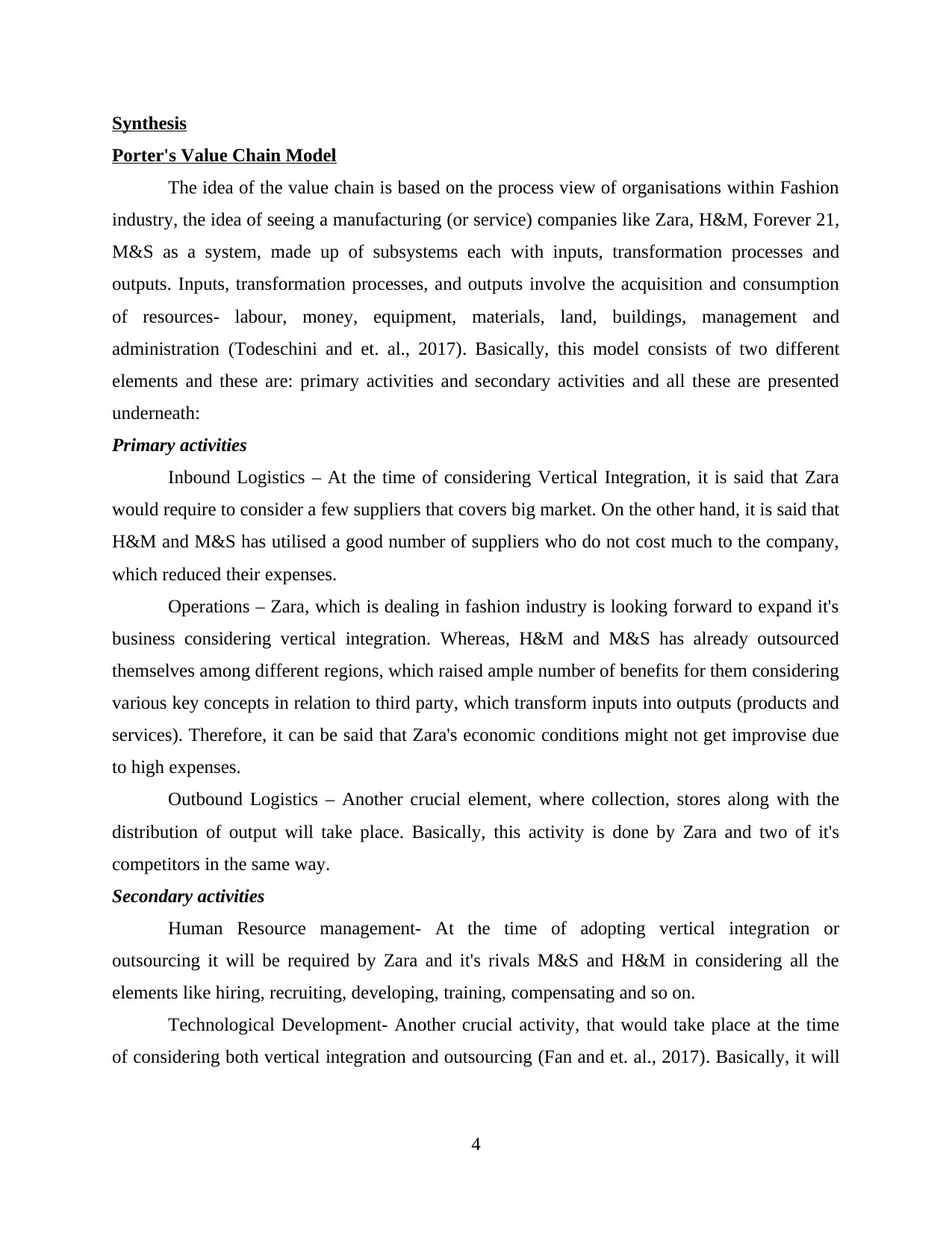
Synthesis
Porter's Value Chain Model
The idea of the value chain is based on the process view of organisations within Fashion
industry, the idea of seeing a manufacturing (or service) companies like Zara, H&M, Forever 21,
M&S as a system, made up of subsystems each with inputs, transformation processes and
outputs. Inputs, transformation processes, and outputs involve the acquisition and consumption
of resources- labour, money, equipment, materials, land, buildings, management and
administration (Todeschini and et. al., 2017). Basically, this model consists of two different
elements and these are: primary activities and secondary activities and all these are presented
underneath:
Primary activities
Inbound Logistics – At the time of considering Vertical Integration, it is said that Zara
would require to consider a few suppliers that covers big market. On the other hand, it is said that
H&M and M&S has utilised a good number of suppliers who do not cost much to the company,
which reduced their expenses.
Operations – Zara, which is dealing in fashion industry is looking forward to expand it's
business considering vertical integration. Whereas, H&M and M&S has already outsourced
themselves among different regions, which raised ample number of benefits for them considering
various key concepts in relation to third party, which transform inputs into outputs (products and
services). Therefore, it can be said that Zara's economic conditions might not get improvise due
to high expenses.
Outbound Logistics – Another crucial element, where collection, stores along with the
distribution of output will take place. Basically, this activity is done by Zara and two of it's
competitors in the same way.
Secondary activities
Human Resource management- At the time of adopting vertical integration or
outsourcing it will be required by Zara and it's rivals M&S and H&M in considering all the
elements like hiring, recruiting, developing, training, compensating and so on.
Technological Development- Another crucial activity, that would take place at the time
of considering both vertical integration and outsourcing (Fan and et. al., 2017). Basically, it will
4
Porter's Value Chain Model
The idea of the value chain is based on the process view of organisations within Fashion
industry, the idea of seeing a manufacturing (or service) companies like Zara, H&M, Forever 21,
M&S as a system, made up of subsystems each with inputs, transformation processes and
outputs. Inputs, transformation processes, and outputs involve the acquisition and consumption
of resources- labour, money, equipment, materials, land, buildings, management and
administration (Todeschini and et. al., 2017). Basically, this model consists of two different
elements and these are: primary activities and secondary activities and all these are presented
underneath:
Primary activities
Inbound Logistics – At the time of considering Vertical Integration, it is said that Zara
would require to consider a few suppliers that covers big market. On the other hand, it is said that
H&M and M&S has utilised a good number of suppliers who do not cost much to the company,
which reduced their expenses.
Operations – Zara, which is dealing in fashion industry is looking forward to expand it's
business considering vertical integration. Whereas, H&M and M&S has already outsourced
themselves among different regions, which raised ample number of benefits for them considering
various key concepts in relation to third party, which transform inputs into outputs (products and
services). Therefore, it can be said that Zara's economic conditions might not get improvise due
to high expenses.
Outbound Logistics – Another crucial element, where collection, stores along with the
distribution of output will take place. Basically, this activity is done by Zara and two of it's
competitors in the same way.
Secondary activities
Human Resource management- At the time of adopting vertical integration or
outsourcing it will be required by Zara and it's rivals M&S and H&M in considering all the
elements like hiring, recruiting, developing, training, compensating and so on.
Technological Development- Another crucial activity, that would take place at the time
of considering both vertical integration and outsourcing (Fan and et. al., 2017). Basically, it will
4
Paraphrase This Document
Need a fresh take? Get an instant paraphrase of this document with our AI Paraphraser
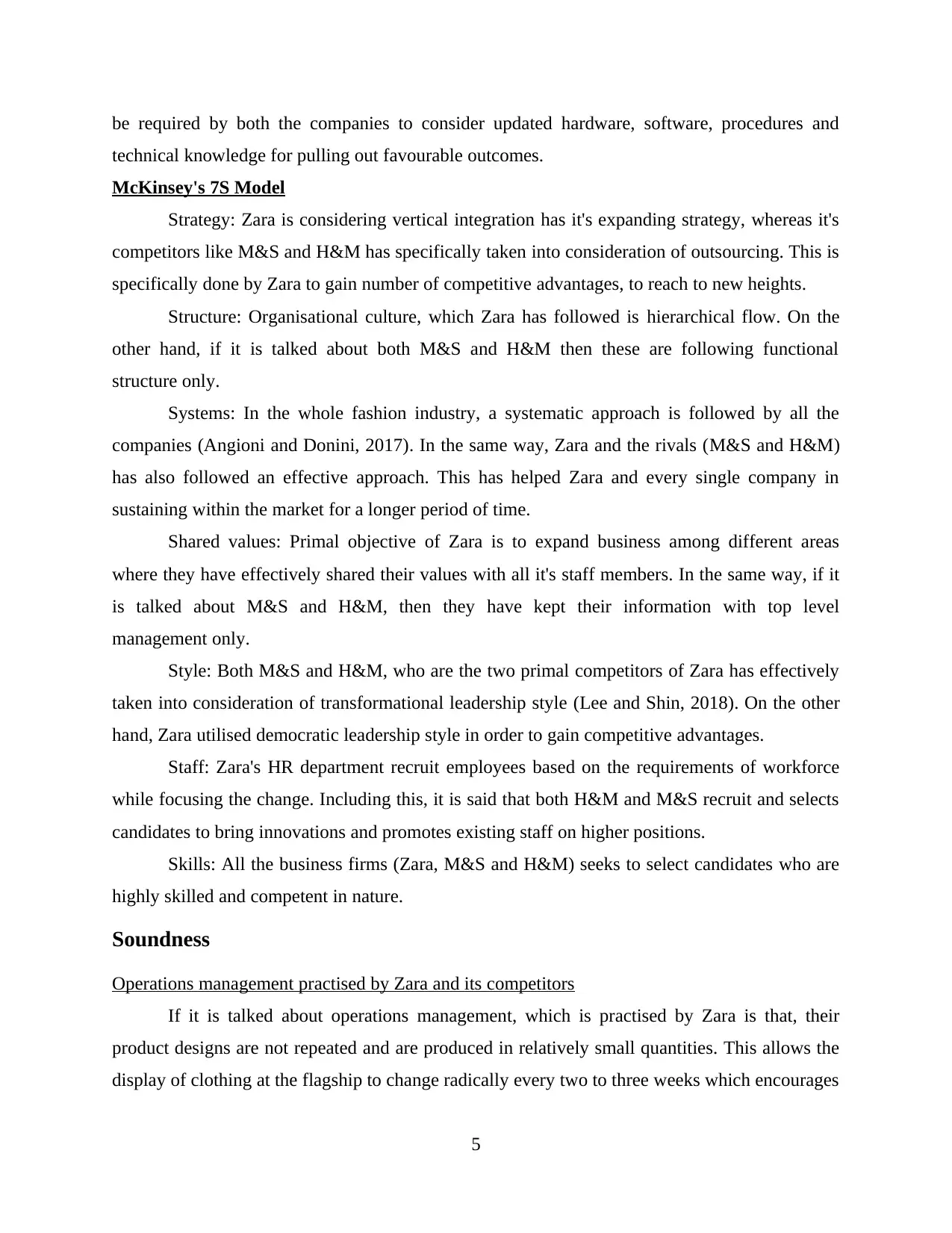
be required by both the companies to consider updated hardware, software, procedures and
technical knowledge for pulling out favourable outcomes.
McKinsey's 7S Model
Strategy: Zara is considering vertical integration has it's expanding strategy, whereas it's
competitors like M&S and H&M has specifically taken into consideration of outsourcing. This is
specifically done by Zara to gain number of competitive advantages, to reach to new heights.
Structure: Organisational culture, which Zara has followed is hierarchical flow. On the
other hand, if it is talked about both M&S and H&M then these are following functional
structure only.
Systems: In the whole fashion industry, a systematic approach is followed by all the
companies (Angioni and Donini, 2017). In the same way, Zara and the rivals (M&S and H&M)
has also followed an effective approach. This has helped Zara and every single company in
sustaining within the market for a longer period of time.
Shared values: Primal objective of Zara is to expand business among different areas
where they have effectively shared their values with all it's staff members. In the same way, if it
is talked about M&S and H&M, then they have kept their information with top level
management only.
Style: Both M&S and H&M, who are the two primal competitors of Zara has effectively
taken into consideration of transformational leadership style (Lee and Shin, 2018). On the other
hand, Zara utilised democratic leadership style in order to gain competitive advantages.
Staff: Zara's HR department recruit employees based on the requirements of workforce
while focusing the change. Including this, it is said that both H&M and M&S recruit and selects
candidates to bring innovations and promotes existing staff on higher positions.
Skills: All the business firms (Zara, M&S and H&M) seeks to select candidates who are
highly skilled and competent in nature.
Soundness
Operations management practised by Zara and its competitors
If it is talked about operations management, which is practised by Zara is that, their
product designs are not repeated and are produced in relatively small quantities. This allows the
display of clothing at the flagship to change radically every two to three weeks which encourages
5
technical knowledge for pulling out favourable outcomes.
McKinsey's 7S Model
Strategy: Zara is considering vertical integration has it's expanding strategy, whereas it's
competitors like M&S and H&M has specifically taken into consideration of outsourcing. This is
specifically done by Zara to gain number of competitive advantages, to reach to new heights.
Structure: Organisational culture, which Zara has followed is hierarchical flow. On the
other hand, if it is talked about both M&S and H&M then these are following functional
structure only.
Systems: In the whole fashion industry, a systematic approach is followed by all the
companies (Angioni and Donini, 2017). In the same way, Zara and the rivals (M&S and H&M)
has also followed an effective approach. This has helped Zara and every single company in
sustaining within the market for a longer period of time.
Shared values: Primal objective of Zara is to expand business among different areas
where they have effectively shared their values with all it's staff members. In the same way, if it
is talked about M&S and H&M, then they have kept their information with top level
management only.
Style: Both M&S and H&M, who are the two primal competitors of Zara has effectively
taken into consideration of transformational leadership style (Lee and Shin, 2018). On the other
hand, Zara utilised democratic leadership style in order to gain competitive advantages.
Staff: Zara's HR department recruit employees based on the requirements of workforce
while focusing the change. Including this, it is said that both H&M and M&S recruit and selects
candidates to bring innovations and promotes existing staff on higher positions.
Skills: All the business firms (Zara, M&S and H&M) seeks to select candidates who are
highly skilled and competent in nature.
Soundness
Operations management practised by Zara and its competitors
If it is talked about operations management, which is practised by Zara is that, their
product designs are not repeated and are produced in relatively small quantities. This allows the
display of clothing at the flagship to change radically every two to three weeks which encourages
5
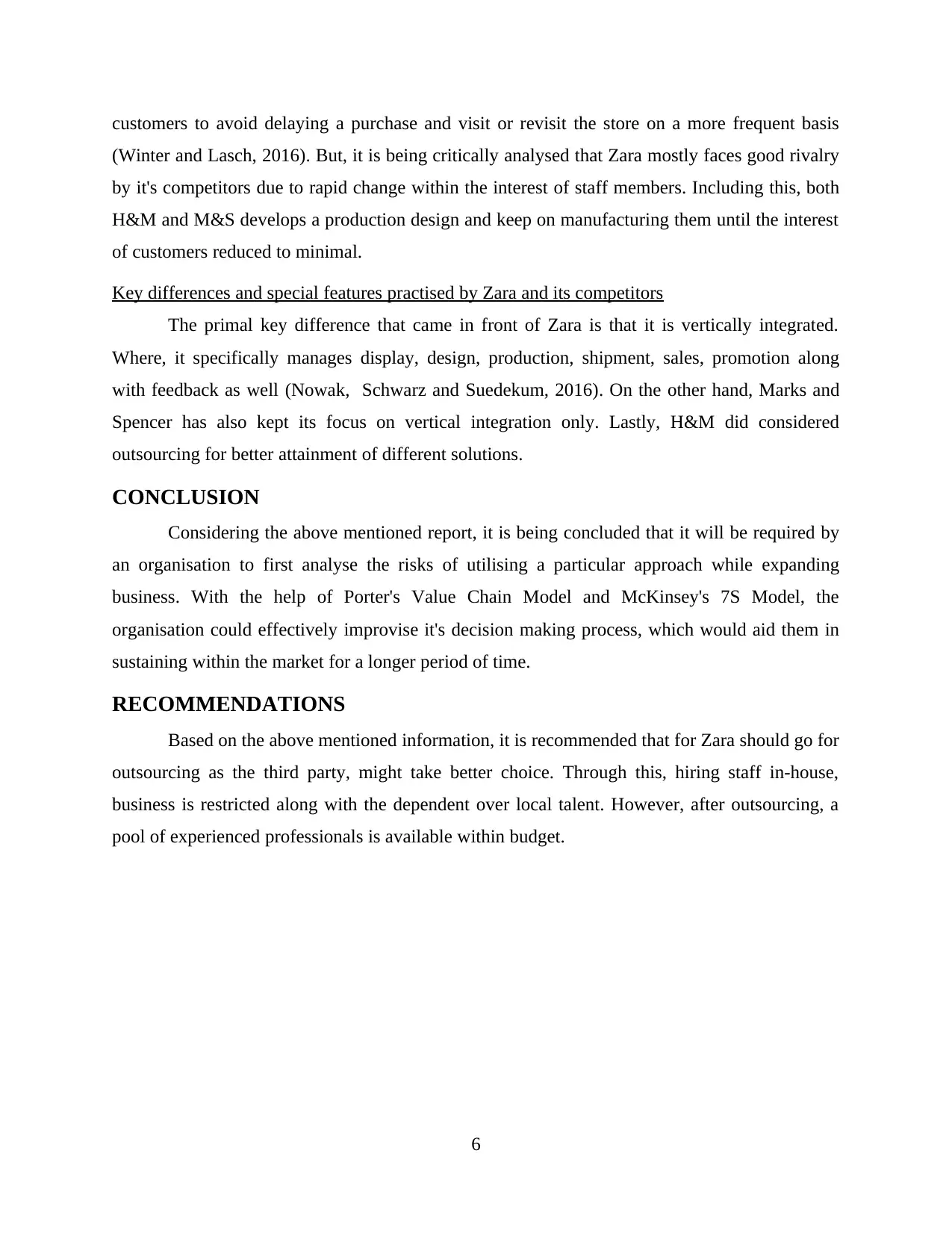
customers to avoid delaying a purchase and visit or revisit the store on a more frequent basis
(Winter and Lasch, 2016). But, it is being critically analysed that Zara mostly faces good rivalry
by it's competitors due to rapid change within the interest of staff members. Including this, both
H&M and M&S develops a production design and keep on manufacturing them until the interest
of customers reduced to minimal.
Key differences and special features practised by Zara and its competitors
The primal key difference that came in front of Zara is that it is vertically integrated.
Where, it specifically manages display, design, production, shipment, sales, promotion along
with feedback as well (Nowak, Schwarz and Suedekum, 2016). On the other hand, Marks and
Spencer has also kept its focus on vertical integration only. Lastly, H&M did considered
outsourcing for better attainment of different solutions.
CONCLUSION
Considering the above mentioned report, it is being concluded that it will be required by
an organisation to first analyse the risks of utilising a particular approach while expanding
business. With the help of Porter's Value Chain Model and McKinsey's 7S Model, the
organisation could effectively improvise it's decision making process, which would aid them in
sustaining within the market for a longer period of time.
RECOMMENDATIONS
Based on the above mentioned information, it is recommended that for Zara should go for
outsourcing as the third party, might take better choice. Through this, hiring staff in-house,
business is restricted along with the dependent over local talent. However, after outsourcing, a
pool of experienced professionals is available within budget.
6
(Winter and Lasch, 2016). But, it is being critically analysed that Zara mostly faces good rivalry
by it's competitors due to rapid change within the interest of staff members. Including this, both
H&M and M&S develops a production design and keep on manufacturing them until the interest
of customers reduced to minimal.
Key differences and special features practised by Zara and its competitors
The primal key difference that came in front of Zara is that it is vertically integrated.
Where, it specifically manages display, design, production, shipment, sales, promotion along
with feedback as well (Nowak, Schwarz and Suedekum, 2016). On the other hand, Marks and
Spencer has also kept its focus on vertical integration only. Lastly, H&M did considered
outsourcing for better attainment of different solutions.
CONCLUSION
Considering the above mentioned report, it is being concluded that it will be required by
an organisation to first analyse the risks of utilising a particular approach while expanding
business. With the help of Porter's Value Chain Model and McKinsey's 7S Model, the
organisation could effectively improvise it's decision making process, which would aid them in
sustaining within the market for a longer period of time.
RECOMMENDATIONS
Based on the above mentioned information, it is recommended that for Zara should go for
outsourcing as the third party, might take better choice. Through this, hiring staff in-house,
business is restricted along with the dependent over local talent. However, after outsourcing, a
pool of experienced professionals is available within budget.
6
⊘ This is a preview!⊘
Do you want full access?
Subscribe today to unlock all pages.

Trusted by 1+ million students worldwide
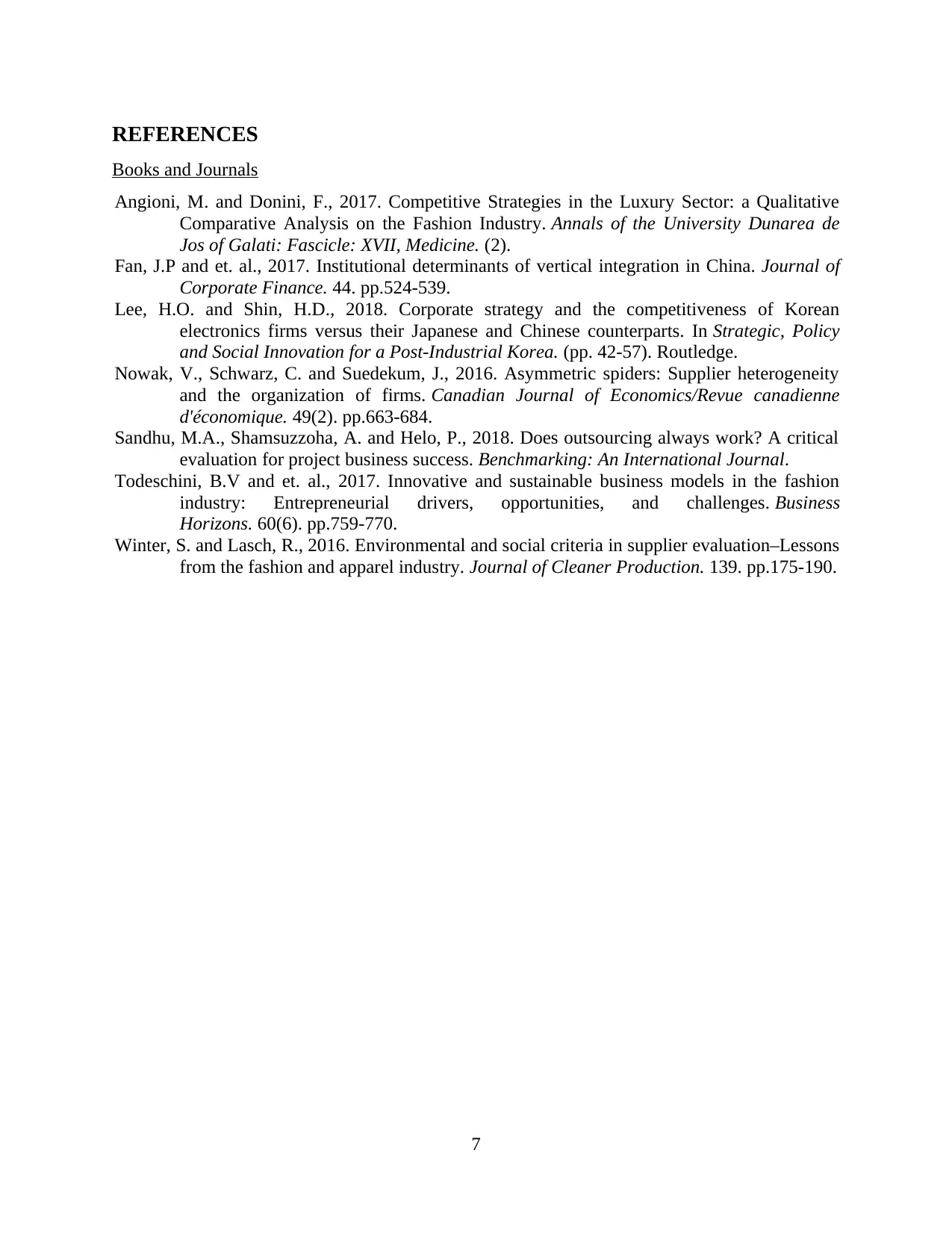
REFERENCES
Books and Journals
Angioni, M. and Donini, F., 2017. Competitive Strategies in the Luxury Sector: a Qualitative
Comparative Analysis on the Fashion Industry. Annals of the University Dunarea de
Jos of Galati: Fascicle: XVII, Medicine. (2).
Fan, J.P and et. al., 2017. Institutional determinants of vertical integration in China. Journal of
Corporate Finance. 44. pp.524-539.
Lee, H.O. and Shin, H.D., 2018. Corporate strategy and the competitiveness of Korean
electronics firms versus their Japanese and Chinese counterparts. In Strategic, Policy
and Social Innovation for a Post-Industrial Korea. (pp. 42-57). Routledge.
Nowak, V., Schwarz, C. and Suedekum, J., 2016. Asymmetric spiders: Supplier heterogeneity
and the organization of firms. Canadian Journal of Economics/Revue canadienne
d'économique. 49(2). pp.663-684.
Sandhu, M.A., Shamsuzzoha, A. and Helo, P., 2018. Does outsourcing always work? A critical
evaluation for project business success. Benchmarking: An International Journal.
Todeschini, B.V and et. al., 2017. Innovative and sustainable business models in the fashion
industry: Entrepreneurial drivers, opportunities, and challenges. Business
Horizons. 60(6). pp.759-770.
Winter, S. and Lasch, R., 2016. Environmental and social criteria in supplier evaluation–Lessons
from the fashion and apparel industry. Journal of Cleaner Production. 139. pp.175-190.
7
Books and Journals
Angioni, M. and Donini, F., 2017. Competitive Strategies in the Luxury Sector: a Qualitative
Comparative Analysis on the Fashion Industry. Annals of the University Dunarea de
Jos of Galati: Fascicle: XVII, Medicine. (2).
Fan, J.P and et. al., 2017. Institutional determinants of vertical integration in China. Journal of
Corporate Finance. 44. pp.524-539.
Lee, H.O. and Shin, H.D., 2018. Corporate strategy and the competitiveness of Korean
electronics firms versus their Japanese and Chinese counterparts. In Strategic, Policy
and Social Innovation for a Post-Industrial Korea. (pp. 42-57). Routledge.
Nowak, V., Schwarz, C. and Suedekum, J., 2016. Asymmetric spiders: Supplier heterogeneity
and the organization of firms. Canadian Journal of Economics/Revue canadienne
d'économique. 49(2). pp.663-684.
Sandhu, M.A., Shamsuzzoha, A. and Helo, P., 2018. Does outsourcing always work? A critical
evaluation for project business success. Benchmarking: An International Journal.
Todeschini, B.V and et. al., 2017. Innovative and sustainable business models in the fashion
industry: Entrepreneurial drivers, opportunities, and challenges. Business
Horizons. 60(6). pp.759-770.
Winter, S. and Lasch, R., 2016. Environmental and social criteria in supplier evaluation–Lessons
from the fashion and apparel industry. Journal of Cleaner Production. 139. pp.175-190.
7
1 out of 7
Related Documents
Your All-in-One AI-Powered Toolkit for Academic Success.
+13062052269
info@desklib.com
Available 24*7 on WhatsApp / Email
![[object Object]](/_next/static/media/star-bottom.7253800d.svg)
Unlock your academic potential
Copyright © 2020–2025 A2Z Services. All Rights Reserved. Developed and managed by ZUCOL.





